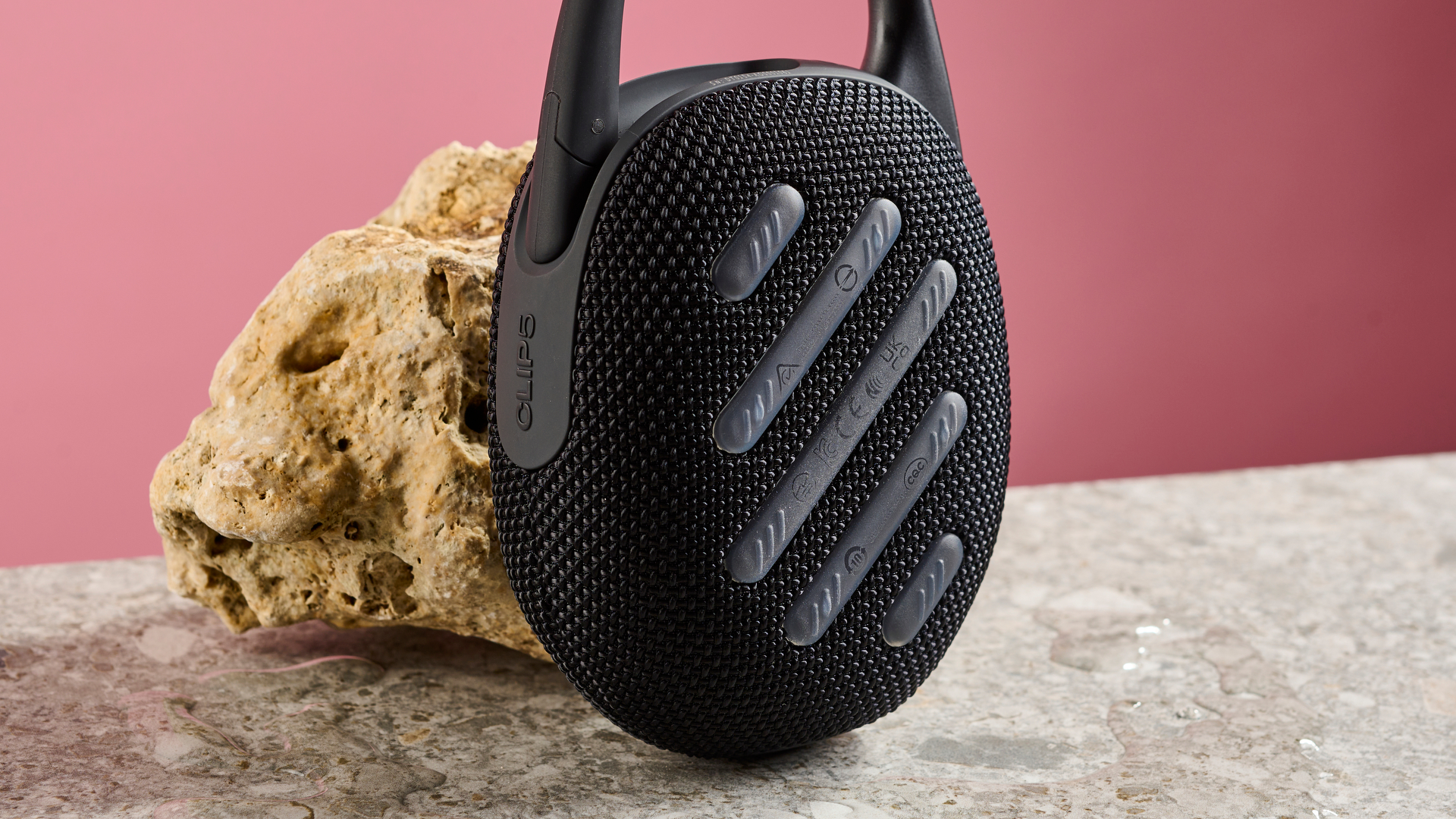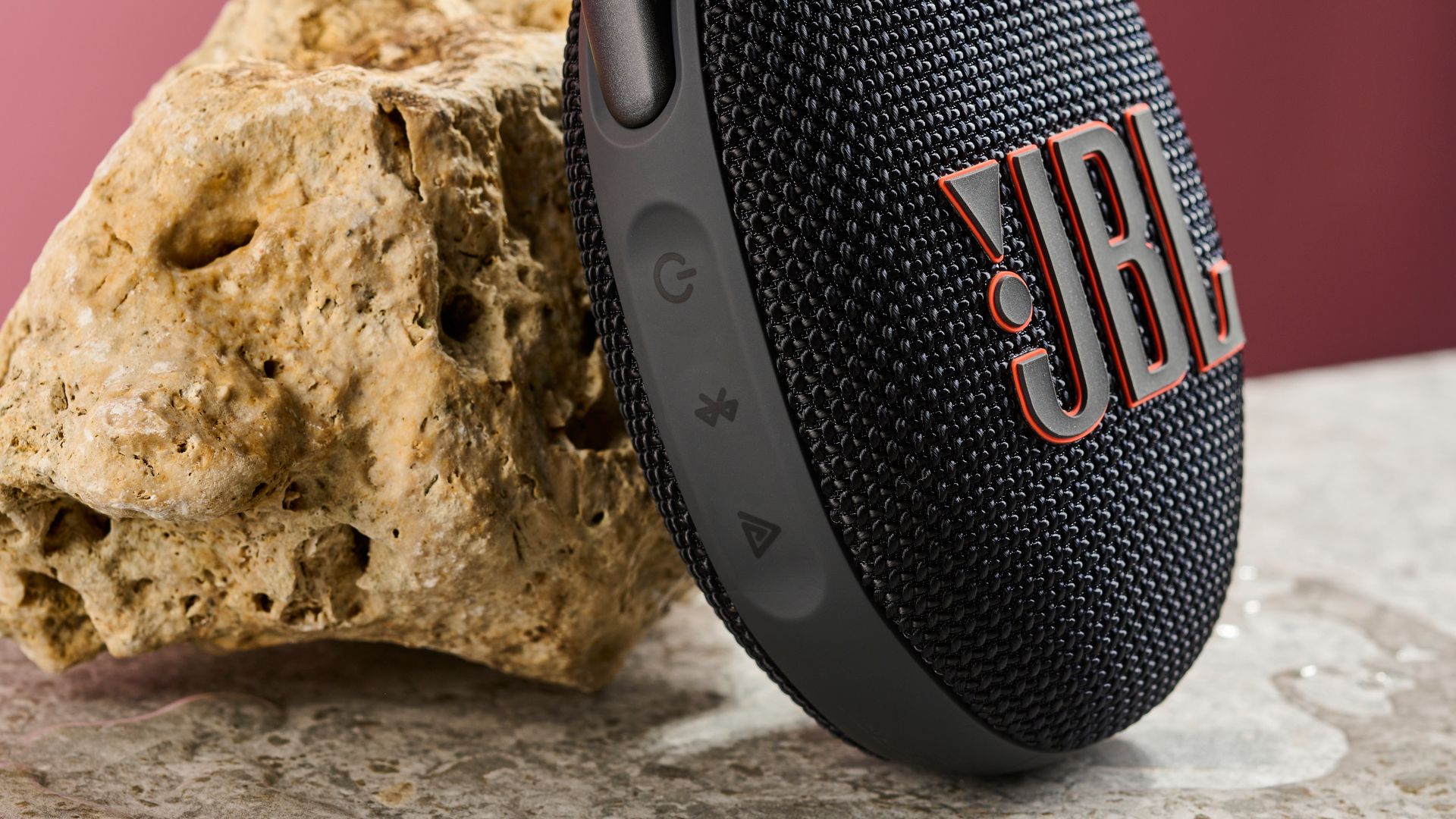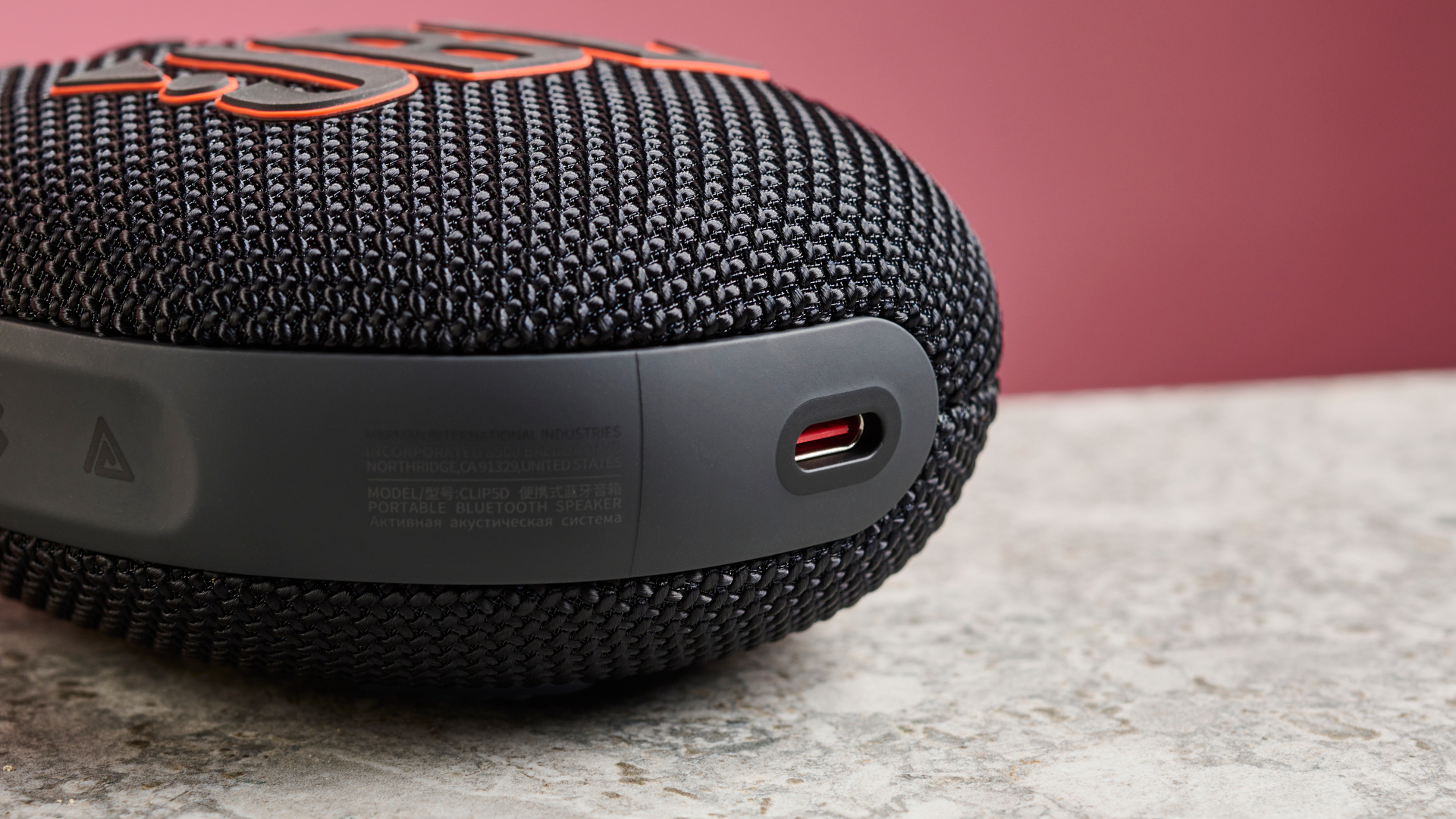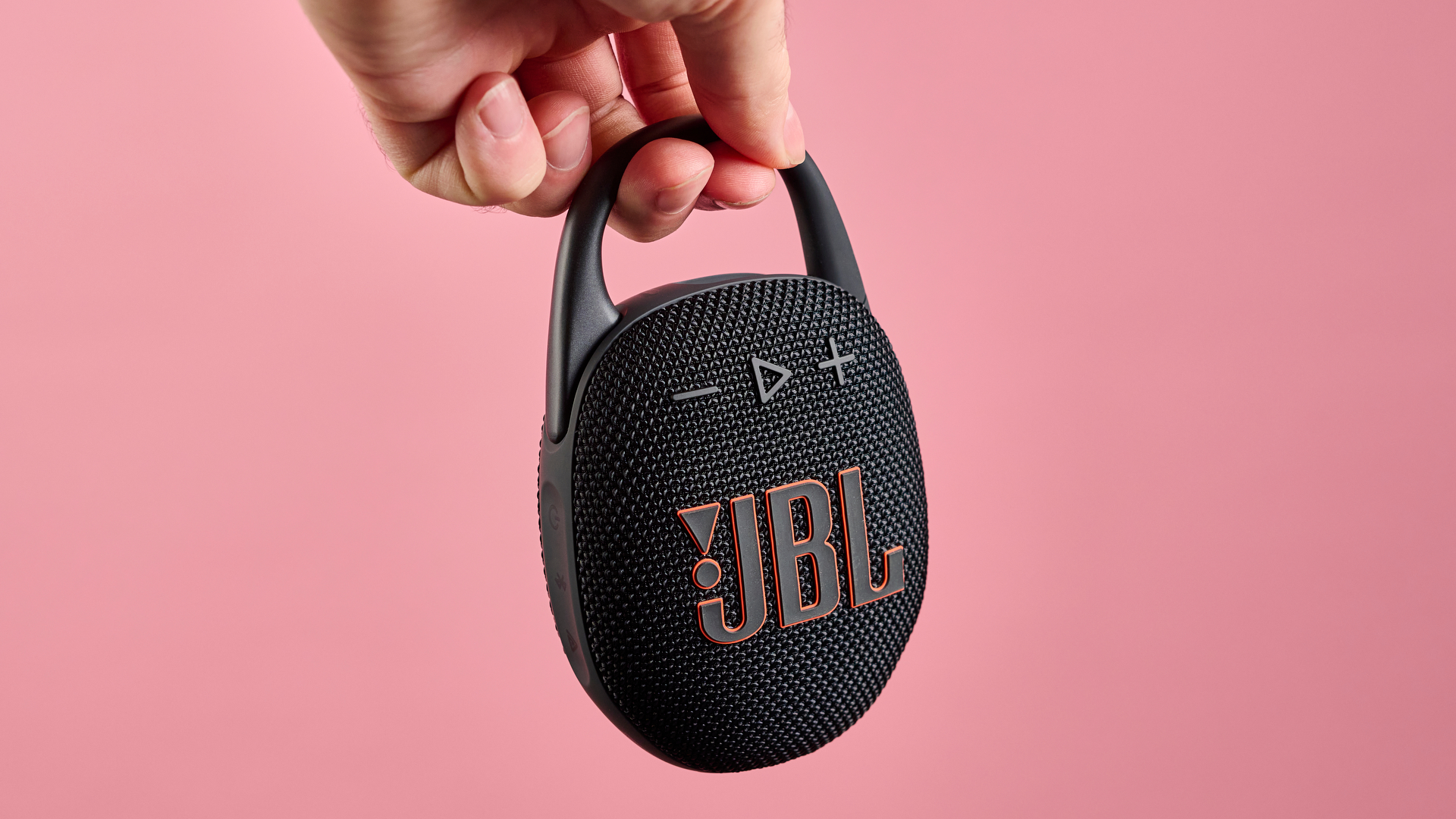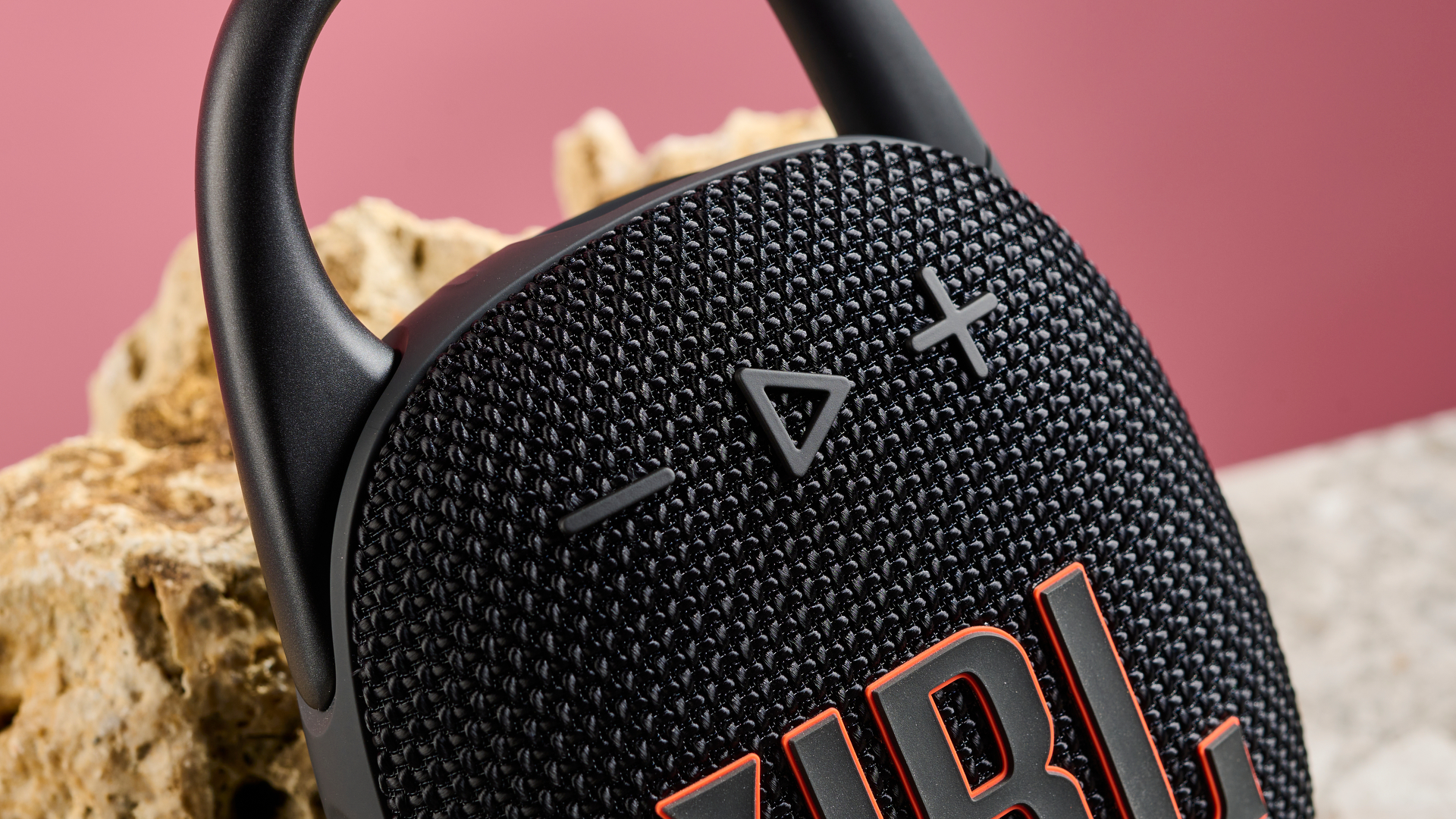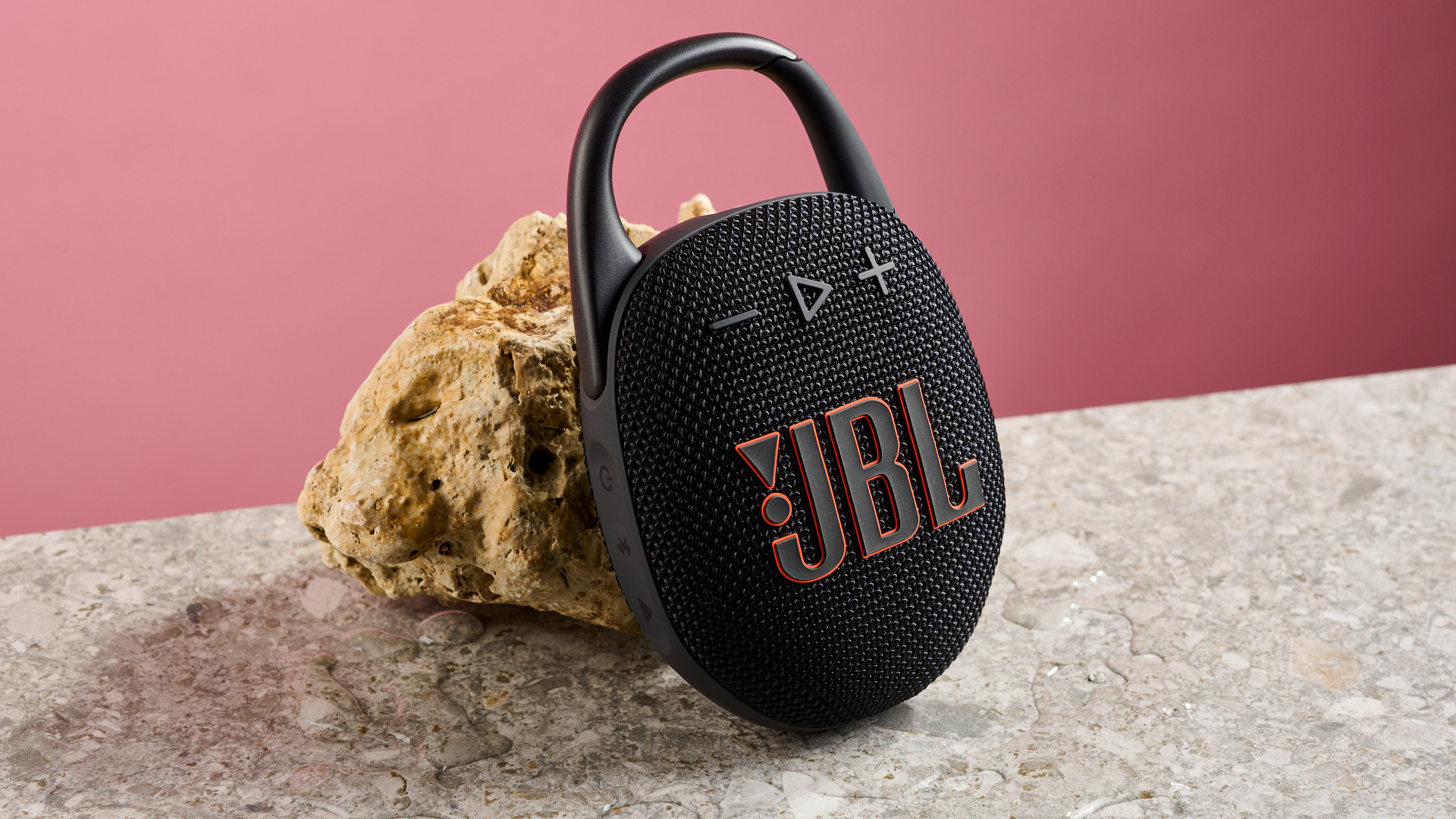The JBL Clip 5 is reasonably priced at $79.95 / £59.99 / AU$89.95 and is available in the US, the UK, and Australia. Considering that the JBL Go 4 costs $49.95 / £39.99 / AU$59.95, if your budget can stretch to the JBL Clip 5 the extra investment will return big gains in sound quality and volume levels.
From minute one I was impressed with what this compact Bluetooth speaker had to offer. The Clip 5 is a satisfying mix of durability, practicality, and enjoyable sound in a small package. Is it one of the best Bluetooth speakers around? All in good time.
The JBL Clip 5 is covered in woven fabric on the front and back, with a silicone mid-section. It has a large plastic carabiner on the top that’s easy to open and clip onto things. I’ve had it hanging from door handles, the bathroom mirror, and shelving units amongst other places, and could easily change up its position to allow for the best listening experience.
There are silicone strips on the back of the speaker body for added stability when the speaker is placed face-up on a surface, and the JBL logo on the front of the speaker is also made from silicone. Above the logo are the play/pause button and the volume up and volume down buttons. These have icons that represent the respective functions – so, a triangular ‘play’ icon, and plus and minus signs – and I found them satisfying to press. Within the silicone area on the left-hand side of the speaker sit the power, Bluetooth and Auracast buttons.
This pint-sized speaker measures just 3.4 x 5.3 x 1.8 inches / 86 x 134.5 x 46mm, but at 10 ounces / 285g, it feels a little heavy for its size. It’s a shame that it’s only possible to hang the Clip 5 or lie it on its back; there was many an occasion when it would have been more convenient to stand it on its base, but its pebble-like shape makes it unstable.
The speaker has IP67 water and dust protection, meaning I wasn’t limited to where I could listen to tunes. It quickly became my favorite bath-time companion, and the steam was no issue for it. We also did a dunk test in the TechRadar testing tank, after which the Clip 5 continued to function quite happily, so whether you want to listen to tunes on the beach or do karaoke in the shower, it looks like this speaker can handle it. JBL has adopted a sustainable approach with the Clip 5 by incorporating some post-consumer recycled materials in the design. Great stuff.
If you’ve read my JBL Go 4 versus feature, you’ll already know I’m a fan of the JBL Portable app’s user-friendly interface. It has an attractive, easy-to-use design that makes it a snap to view the battery level, use Stereo Group mode to play in stereo from two speakers, or use the PartyTogether mode to add other JBL speakers into the mix for amped-up sound.
Further features on the app include PlaytimeBoost, which is designed to boost the volume of the music without consuming more battery power, a Product Information section, and an EQ settings section. There are four equalizer profile presets: JBL Signature, Chill, Energetic, and Vocal, as well as a customizable EQ profile.
I tested out the Clip 5’s Auracast capabilities by connecting it with a JBL Xtreme 4 and Go 4 speaker. The connection process was easy thanks to PartyTogether mode, and the resulting surround sound effect was impressive. I must admit that my colleague, audio expert Harry Padoan, and I couldn’t help but bop along to the tunes in our music testing room.
The battery is said to last up to 12 hours on the JBL website. When I tested it by playing our TechRadar testing playlist non-stop at 50% volume, it lasted just under eleven-and-a-half hours, which isn’t bad considering how obnoxiously loud the Clip 5 is when playing at this volume level.
The sound quality of the JBL Clip 5 is pretty impressive considering its size and price. It’s capable of some surprisingly deep bass and delivers this without losing the detail, even when just using the default JBL Signature EQ setting.
When I laid the speaker down, I could feel the bass pounding through the surface it was on. Not only was the bass impactful and dynamic in tracks like Black Eye by Allie X, but it also delivered low-frequency bass impressively well when I listened to Angel by Massive Attack.
Unfortunately, there was a shortcoming that became apparent when listening to Black Eye. The vocals came across slightly strained and overpowering when listening to the track at 75% volume. They were brought more into proportion when the volume was reduced to 50%; the bass continued to bounce dynamically across the track, and I could still hear the detail in the vocals. I changed to the Energetic EQ preset to see if this made any improvements. While it did what it said on the tin and added some energy to the instrumental element of the track, the vocals continued to have a sharp edge to them. As was also the case with the JBL Go 4, changing over to the Vocal EQ preset just results in all the elements sounding distorted, as if they were recorded underwater.
When listening to Hit the Road Jack by 2WEI and Bri Bryant, the delivery was satisfyingly atmospheric and immersive considering the size of the Clip 5. The different elements layered together well. The bass was dramatic and impactful, and I could hear the finer details in the background of the track as the beat was building up.
Cheaper speakers can struggle with the treble and intensity of some vocal sections on this track, making them sound tinny and strained. The Clip 5 handled it well, but the tinniness did appear at around 75% volume, which seemed to be a running theme when I listened to various tracks. The song Boom Boom by the same artists sounded good at 75%, with plenty of detail and drama, but the highs again began to feel a little harsh; at 50% volume, everything blended together a bit better. So this definitely wouldn’t make a replacement for a party speaker if you wanted to blast out the tunes at a get-together.
Adagio Per Archi E Organo In Sol Minore by the London Philharmonic Orchestra was a satisfying listen with this speaker; there was a clear distinction between the different notes and instruments, but a slightly tinny edge to the sounds of the organ. This will likely only be noticed by audiophiles who are scrutinizing the sound quality, however. I don’t imagine anyone expects perfection at this price point but, actually, outside of the treble troubles, the Clip 5 is certainly reaching for it.
Another enjoyable listen was I Believe in a Thing Called Love by The Darkness. The guitar and vocals sounded great, and everything was well-proportioned. I could easily hear the detail and depth in Justin’s voice, and the instruments layered together well, with nothing stepping out of line or trying to steal the limelight when it shouldn’t have been.
The difference between the sound quality of the Clip 5 and the cheaper JBL Go 4 is certainly noticeable. While there is of course a $30 price difference to consider, I’d say it’s worth it if you want deeper bass and the ability to blast out some tunes without lugging about a bigger speaker – though there’s naturally some sacrifice when it comes to sound quality at the higher end of the volume scale.
If you’re still undecided whether the JBL Clip 5 covers all your bases, we’ve curated a list of the best Bluetooth speakers with alternatives suitable for varied budgets and requirements. We also keep track of the best cheap Bluetooth speaker deals, so it’s worth checking back now and then to see if there’s money to be saved.
JBL Clip 5 review: Price & release date
Table of Contents
- List price: $79.95 / £59.99 / AU$89.95
- Available now in the US, UK, and Australia
The JBL Clip 5 was released in June 2024 and is one of JBL’s first speakers to include Auracast capabilities, along with the Xtreme 4 and Go 4. It’s available directly from the JBL website in the US, UK, and Australia for $79.95 / £59.99 / AU$89.95.
JBL Clip 5 review: Specs
| Drivers | Integrated class D digital amplifiers x 1 |
| Dimensions | 3.4 x 5.3 x 1.8 inches / 86 x 134.5 x 46 mm |
| Weight | 10 ounces / 285g |
| Connectivity | Bluetooth 5.3, USB-C (charging) |
| Battery life (quoted) | Up to 12 hours |
| Waterproof rating | IP67 |
| App available | Yes |
Should I buy the JBL Clip 5?
| Section | Notes | Score |
|---|---|---|
| Features | The JBL Portable app is simple and enjoyable to use, and the Auracast function worked well across three different JBL speakers. This speaker really blasts out the tunes at 50% volume, so a battery life of just under eleven and a half hours didn’t disappoint. | 4/5 |
| Sound quality | Can struggle with treble at higher volumes, coming through with a sharp, tinny edge, but mids and bass have no problem. The amount of detail on offer, even when the bass is thumping, is impressive. | 4.5/5 |
| Design | The carabiner makes for a useful design feature, plus the range of colors available and the IP67 rating make it all the more attractive. It is let down slightly by its old-school appearance and its inability to stand on its base though. | 4/5 |
| Value | The fact that this compact, IP67-rated, punchy, and portable speaker costs less than $80 leaves no room for doubt, this speaker is definitely good value for money. | 5/5 |
Buy it if…
Don’t buy it if…
JBL Clip 5 review: Also consider
| JBL Clip 5 | Tribit XSound Plus 2 | Ultimate Ears Wonderboom 3 | |
|---|---|---|---|
| Price | $79.95 / £59.99 / $89.95 | $69.99 / £63 (about AU$105) | $99.99 / £89.99 / AU$149 |
| Weight | 10 ounces / 285g | 1.76lbs / 798g | 14.8oz / 420g |
| Dimensions | 3.4 x 5.3 x 1.8 inches / 86 x 134.5 x 46 mm | 7.81 x 2.62 x 2.76 inches / 198.5 x 66.5 x 70mm | 4 x 3.75 x 3.75 in / 104 x 95.3 x 95.3 mm |
| Drivers | Integrated class D digital amplifiers x 1, Passive bass radiator | 2x 15W neodymium full-range drivers | 2x 40mm active drivers, 2x 46.1mm x 65.2mm passive radiators |
| Battery life (quoted) | Up to 12 hours | 24 hours | 14 hours |
| Waterproof rating | IP67 | IPX7 | IP67 |
How I tested the JBL Clip 5
- I tested the speaker over several months
- I listened to a variety of music genres and podcasts
- I played music continuously to determine battery usage
I tested the JBL Clip 5 over a few months. I listened to a variety of music genres, as well as the TechRadar testing playlist that includes tracks ranging from complex and layered instrumentals to deep bass and delicate vocals. This enabled me to determine the speaker’s ability to handle different frequencies.
I played our TechRadar playlist on Tidal continuously at 50% volume using the default JBL signature EQ preset to test whether the battery could last up to 12 hours.
I used it to listen to music and podcasts in the TechRadar office, our music testing room, and at home, using Spotify and Tidal from an iPhone 12 Pro and a OnePlus Pad Go.


